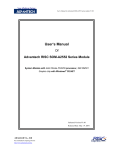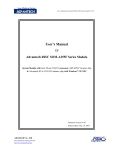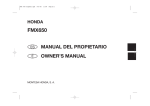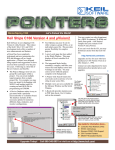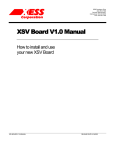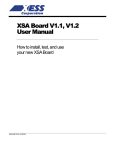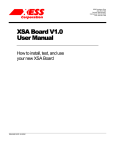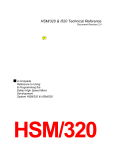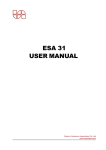Download Application Note 141 Controlling a DS1804 Using an 8051
Transcript
Application Note 141 Controlling a DS1804 Using an 8051Compatible Microcontroller www.dalsemi.com Introduction The DS1804 Nonvolatile (NV) Trimmer Potentiometer is ideal for use in any system that requires a biasing voltage, current, or resistance with or without manual adjustments. Its increment/decrement interface allows either the use of minimal external hardware for manual adjustments or a microcontoller for autonomous operation. The wiper can be adjusted to one of 100 positions, and any value can be stored in the part’s NV register to select the wiper value at power-up. The part also offers several small packaging options, including 8-pin DIP, SOIC, µSOP, and flip-chip packages. This application note provides a simple hardware and software set-up for controlling the DS1804 with a Dallas Semiconductor DS87C520 (8051) Microcontroller. Hardware Setup for Microcontoller Communication with a DS1804 One of the primary benefits of using a DS1804 is the simplicity of the hardware and software control interface. Only three connections are required between the potentiometer and the microcontroller: chip select, up/down select, and increment, which are on pins P1.6, P1.5, and P1.4 of the microcontroller in Figure 1, respectively. Two additional components for supporting the 8051 program are shown on the schematic. The first is a DS1075 EconOscillator chip that provides a 22.22 MHz clock for the 8051; an LED attached to P1.0 is the second. Functioning as a status indicator in the program, the LED is toggled intermittently to show that the program is still executing. Figure 1. Schematic Showing the DS87C520, DS1804, and DS1075 Connections The DS1075 can be replaced with a 22.118 MHz crystal. Instructions for operating the DS87C520 with a crystal clock source are available in Dallas Semiconductor’s High Speed Microcontroller User’s Manual. It should be noted that the DS87C520 is capable of operating with up to a 33 MHz clock; however, the delays used in the software depend upon the clock frequency. Operating the DS87C520 at a higher clock rate can potentially cause timing faults with the DS1804, while operating at a lower frequency should have no ill effects. 1 of 11 031201 AN 141 Using the CS, INC, and UD Signals to Control the DS1804 Operation of the DS1804 is simple, but a couple of nuances need to be understood for reliable operation. First, the device powers up over the course of 50ms. Attempts to signal information to the part before that period of time elapses will not be successful. The part also requires 500µs to adjust the value of the wiper to the value stored in the non-volatile register during power-up. After power-up, there are two ways to increment or decrement the part. The first method only changes the value of the potentiometer wiper position. The second changes both the value of the wiper and writes the current value to the non-volatile register. Changing the wiper position without writing to the non-volatile register is accomplished by the following: 1. 2. 3. 4. 5. 6. Adjust the up/down select input to high for increment or low for decrement. Enable the chip by asserting the CS signal (active low). Pulse INC low n-1 times to in/decrement the part n times. Assert INC low again (the part in/decrements one more time on the falling edge of INC). Disable the chip by de-asserting CS. De-assert INC to complete the write. To change the value of the wiper and write the final wiper position to the nonvolatile register, complete the following sequence: 1. 2. 3. 4. 5. Adjust the up/down select input to high for increment or low for decrement. Enable the chip by asserting the CS signal (active low). Pulse the increment signal low n times to in/decrement the part n positions. Disable the chip by de-asserting CS. Wait 10ms for present wiper position to be written to NV register. Another simple, useful routine stores the current value of the wiper position into the NV register. Pulsing CS low while increment remains high stores the current value of the wiper into the NV register. After CS is de-asserted, the controller should wait for 10ms to elapse for the NV register to be written with the present wiper position. 8051 Software for Controlling a DS1804 There are millions of different routines that could be used for adjusting the wiper position and writing to the NV register of a DS1804; however, the easiest method requires only four routines. These routines initialize the DS1804, increment the chip one wiper position, decrement the chip one wiper position, and write the current wiper position to the NV register. These routines are provided in Appendix A, and are called Init1804, Increment1804, Decrement1804, and WriteNVreg. The Increment1804 and Decrement1804 routines can be placed in a loop to in/decrement the DS1804 n times, and once the desired wiper location is reached it can be written to the NV register by calling the WriteNVreg routine. If it is desirable to in/decrement the DS1804 n times without writing the loop in the main program, a short routine could be written that receives n from the stack or the accumulator and implements the loop’s function. The downfall of using only four functions occurs when the overhead of selecting Up/Down and CS during each adjustment slows operation down too much for the application at hand. Thus, two additional functions are included that demonstrate in/decrementing the chip (five intervals each way) with a single selection both the direction and chip select inputs. These routines are called Increment1804x5 and Decrement1804x5. 2 o f 11 AN 141 In addition to the routines described above, three other routines reside in the software to generate timing. They are called wait16us, wt and wait3sec. These function provide a fixed 1.6µs delay, a variable delay that is selected by the values stored in R5, R6, and R7, and a fixed 3-second delay that is used in the main program. Main Program Sequence 1. Disables all interrupts. 2. Toggles LED on P1.0 to signify beginning of execution. 3. Initializes the DS1804 by setting all three DS1804 inputs high and waiting 50ms. 4. Waits 3 seconds, toggles LED. The 3-second delay allows the power up value of the DS1804 to be read with a multi-meter, and the LED indicates when changes are occurring. 5. Increments the DS1804 in 5 interval bursts, a total of 25 positions. A 3-second pause has been added between each of the 5-interval bursts to allow a multi-meter to monitor the changes. The LED will toggle as the changes to the wiper occur. 6. Waits 3 seconds, toggles the LED, and decrements the DS1804 5 intervals. 7. Writes the NV register to the current value. 8. Waits 3 seconds, toggles the LED, and increments the DS1804 1 interval. 9. Waits 3 seconds, toggles the LED, and decrements the DS1804 1 interval. 10. Completes execution with an infinite loop. Main Program Output Assume that you are executing the program with Vcc at 5V with a 22 MHz crystal; a multi-meter is connected between W and Gnd; and cycling Vcc from Gnd to 5V starts the program. The output of the DS1804 will be as follows. When power is turned on, the part will boot up to the value last stored in the NV register. If the value of the NV register was previously written, then it will display that value; otherwise it will display the pseudorandom value stored in the NV register by the factory before shipping. The wiper output will display the voltage on the multi-meter that corresponds to the value stored in the NV register for 3 seconds. The output will then incremented in 0.25V steps and hold each value for 3 seconds before moving on to then next position. This will occur five times for a total voltage change of 1.25V. The wiper voltage will then be lowered 0.25V, and that value will be held for 3 seconds. This value will be stored in the NV register and will be the value that the part boots up to the next time power is cycled. Finally, the wiper voltage will be incremented 0.05V and then decremented 0.05V, with both values being held for 3 seconds. The LED attached to P1.0 will be toggled every 3 seconds directly before every change occurs. In the event that the chip powers up with a wiper value equal to or greater than 3.76V, the program will attempt to increment the chip past 5V. This does not damage the part, but the output will remain at 5V until a decrement command is issued. Thus the end voltage in this case would be 4.75V. 3 o f 11 AN 141 Dallas Semiconductor Contact Information Address: 4401 S. Beltwood Parkway Dallas, TX 75244 Tel: 972-371-4448 Fax: 972-371-4799 World Wide Web Site: www.dalsemi.com Product Literature: (972) 371-4448 FTP Site: ftp://ftp.dalsemi.com Sales and Customer Service: (972) 371-4969 Datasheets: www.dalsemi.com/datasheets/pdfindex.html Ordering Information: www.dalsemi.com/products/ordering.pdf Package/Mechanical Drawings: www.dalsemi.com/datasheets/mechdwg.html 4 o f 11 AN141 Appendix A – 8051 Software Used to Communicate with the DS1804 ;********************************************************************* ;* DS87C520 APPS DEVELOMENT SYSTEM * ;* * ;* Application: Communication with a DS1804 * ;********************************************************************* ;* * ;* Software Revision History * ;* * ;* 1.0 02/07/01 - First try at operating a DS1804 using the * ;* generic application engineering generic 8051 * ;* boot loading board. * ;* * ;* Hardware Description * ;* * ;* P1.0 - LED P0.0 - SN74F373N * ;* P1.1 P0.1 " * ;* P1.2 - RXD1 – Not used P0.2 " * ;* P1.3 - TXD1 – Not used P0.3 " * ;* P1.4 - nInc P0.4 " * ;* P1.5 - UnD P0.5 " * ;* P1.6 - nCS P0.6 " * ;* P1.7 P0.7 " * ;* * ;* P3.0 - RXD0 - Not used P2.0 - Upper * ;* P3.1 - TXD0 - Not used P2.1 - Address * ;* P3.2 P2.2 - Byte * ;* P3.3 P2.3 - " * ;* P3.4 P2.4 - " * ;* P3.5 P2.5 - " * ;* P3.6 - WR\ P2.6 - " * ;* P3.7 - RD\ P2.7 - " * ;* * ;* Window 0 R0 - Used as scratch pad, destroy with caution! * ;* Window 0 R5-R7 Used for timer/scratch pad, destroy with caution! * ;********************************************************************* $include (c:\firmware\reg520.inc) ; SFR register defs for compiler ;************* Variable Declarations ************* ;** General Variables ** stack equ 02Fh ; bottom of stack ; stack starts at 30h ;************* SFR Declarations ************* ;** General SFR Names ** smod_1 equ 0DFh ; buad rate doubler bit declared 5 o f 11 AN141 ;** Port 1 Signal Names ** LED equ 90h RX1 TX1 nInc UnD nCS equ equ equ equ equ 92h 93h 94h 95h 96h ; ; ; ; ; ; ; ; P1.0 P1.1 P1.2 P1.3 P1.4 P1.5 P1.6 P1.7 is is is is is is is is LED not used Serial Port 1 RX Serial Port 1 TX not Inc, - 1804 Up not Down - 1804 not ChipSelect - 1804 not used ;********************************************************************* ;* Hardware Interrupt Vectors (Table on page 95 of DS databook) * ;********************************************************************* ;* No Interrupts are enabled in this code. If interrupts are to be * ;* enabled they need to have the label initialized here. * ;********************************************************************* org 0000h ; Power up and Reset ljmp start org 0003h ; External Interrupt 0 ljmp start org 000Bh ; Timer 0 Interrupt ljmp start org 0013h ; External Interrupt 1 ljmp start org 001Bh ; Timer 1 Interrupt ljmp start org 0023h ; Serial Port 0 Interrupt ljmp start org 002Bh ; Timer 2 Interrupt ljmp start org 0033h ; PowerFail Interrupt (DS Priority 1) ljmp start org 003Bh ; Serial Port 1 Interrupt (DALLAS) ljmp start org 0043h ; External Interrupt 2 (DALLAS) ljmp start org 004Bh ; External Interrupt 3 (DALLAS) ljmp start org 0053h ; External Interrupt 4 (DALLAS) ljmp start org 005Bh ; External Interrupt 5 (DALLAS) ljmp start org 0063h ; Watchdog Interrupt (DALLAS) ljmp start org 006Bh ; Real-Time Clock (DALLAS) ljmp start 6 o f 11 AN141 ;********************************************************************* ;**** The Main Program demonstrates using a 8051 to communicate **** ;**** with a DS1804. The program increments and decrements the **** ;**** potentiometer without writing the NV Register, and it **** ;**** demonstrates writing to the NV Register as well. **** ;********************************************************************* org 0080h ; location that hardware begins execution start: ; after a reset. clr EA ; Disable Interrupts cpl LED ; Complement LED - Identifies that the ; program has started execution lcall init1804 ; initializes DS1804, must be done in first ; 50ms to avoid the three inputs becoming ; active without them being in a known ; state. lcall wait3sec ; give time to read the last NVReg value ; on a multimeter cpl LED ; toggle LED mov R0, #5 ; increment the 1804 by 5 intervals, 5 times, loop10: ; with 3 seconds between increments lcall Increment1804x5 ; increment the DS1804 lcall wait3sec ; waits 3 seconds cpl LED ; toggle LED djnz R0, loop10 lcall Decrement1804x5 ; decrement the 1804 5 intervals cpl LED ; toggle LED lcall WriteNVreg ; write current value to NVReg. Now 20 steps ; greater that the start of execution. lcall wait3sec ; wait 3 seconds for multimeter use cpl LED ; complement LED lcall Increment1804 ; increment 1804 once, don't write NVReg lcall wait3sec ; wait 3 seconds for multimeter use cpl LED ; Complement LED lcall Decrement1804 ; decrement 1804 once, don't write NVReg lcall wait3sec ; wait 3 seconds for multimeter use cpl LED ; Complement LED EndOfMain: ; wait forever sjmp EndOfMain 7 o f 11 AN141 ;********************************************************************* ;**** Increment DS1804x5 Routine **** ;**** Increments the chip 5 times without de-selecting the **** ;**** the chip between increments. This does not write to the **** ;**** nonvolatile register. **** ;********************************************************************* ;* Uses no other routines, and destroys no registers * ;********************************************************************* Increment1804x5: setb UnD ; select increment clr nCS ; select chip clr nInc ; clear inc - increase to next position setb nInc ; set nInc back to inactive state. clr nInc ; clear inc - increase to next position setb nInc ; set nInc back to inactive state. clr nInc ; clear inc - increase to next position setb nInc ; set nInc back to inactive state. clr nInc ; clear inc - increase to next position setb nInc ; set nInc back to inactive state. clr nInc ; clear inc - increase to next position setb nCS ; set nCS before nInc to avoid writing to ; the NV EEPROM register in the DS1804 setb nInc ; set nInc back to inactive state. ret ;********************************************************************* ;**** Increment DS1804 Routine **** ;**** Increments the chip 1 time, and de-selects the chip **** ;**** without writing to the nonvolatile register. **** ;********************************************************************* ;* Uses no other routines, and destroys no registers * ;********************************************************************* Increment1804: setb UnD ; select increment clr nCS ; select chip clr nInc ; clear inc - increase to next position setb nCS ; set nCS before nInc to avoid writing to ; the NV EEPROM register in the DS1804 setb nInc ; set nInc back to inactive state. ret 8 o f 11 AN141 ;********************************************************************* ;**** Decrement DS1804x5 Routine **** ;**** Decrements the chip 5 times without de-selecting the **** ;**** the chip between decrements. This does not write to the **** ;**** nonvolatile register. **** ;********************************************************************* ;* Uses no other routines, and destroys no registers * ;********************************************************************* Decrement1804x5: clr UnD ; select increment clr nCS ; select chip clr nInc ; clear inc - increase to next position setb nInc ; set nInc back to inactive state. clr nInc ; clear inc - increase to next position setb nInc ; set nInc back to inactive state. clr nInc ; clear inc - increase to next position setb nInc ; set nInc back to inactive state. clr nInc ; clear inc - increase to next position setb nInc ; set nInc back to inactive state. clr nInc ; clear inc - increase to next position setb nCS ; set nCS before nInc to avoid writing to ; the NV EEPROM register in the DS1804 setb nInc ; set nInc back to inactive state. ret ;********************************************************************* ;**** Decrement DS1804 Routine **** ;**** Decrements the chip 1 time, and de-selects the chip **** ;**** without writing to the nonvolatile register. **** ;********************************************************************* ;* Uses no other routines, and destroys no registers * ;********************************************************************* Decrement1804: clr UnD ; select decrement clr nCS ; select chip clr nInc ; clear inc - decrease to next position setb nCS ; set nCS before nInc to avoid writing to ; the NV EEPROM register in the DS1804 setb nInc ; set nInc back to inactive state. ret 9 o f 11 AN141 ;********************************************************************* ;**** DS1804 Write Nonvolatile Register Routine **** ;**** Writes the Nonvolatile Register to the current wiper **** ;**** value, and then waits 10ms for the write to occur. **** ;********************************************************************* ;* Uses wt routine, and destroys registers R5, R6, and R7 * ;********************************************************************* WriteNVreg: clr nCS ; select chip setb nCS ; deselect chip, nInc already high so the ; DS1804 will store to the NV Register mov R5, #255 ; wait 10ms before continuing, the NV Reg. mov R6, #3 ; storage time mov R7, #1 ; lcall wt ; ret ;********************************************************************* ;**** Initialize DS1804 Routine **** ;**** Sets all three control signals to their inactive state, **** ;**** and waits 50ms for the inputs to become active before **** ;**** returning to the main program. **** ;********************************************************************* ;* Uses wt routine, and destroys registers R5, R6, and R7 * ;********************************************************************* init1804: setb nCS ; de-select 1804 setb nInc ; de-activate Increment Signal setb UnD ; select increment mov mov mov lcall ret R5, #255 R6, #15 R7, #1 wt ; wait 50ms, this is done so communication ; will not begin before the DS1804 is ready ; to accept input. ; ;********************************************************************* ;**** Wait 3 Seconds Function **** ;********************************************************************* ;* requires wt routine, and destroys R5, R6 and R7 * ;********************************************************************* wait3sec: mov R5, #255 ; wait 3 sec., this is done so advances can mov R6, #147 ; be watched on a multi-meter mov R7, #6 ; lcall wt ; ret 10 o f 11 AN141 ;********************************************************************* ;**** General Wait Function **** ;**** Can wait anywhere between 14.42us to 221 sec. **** ;**** Waits R7 * 867.6 ms if R5 = R6 = 255 **** ;**** Waits R6 * 3.4 ms if R5 = 255 and R7 = 1 **** ;**** Waits R5 * 13.34us if R6 = R7 = 1 **** ;********************************************************************* ;* requires wait16us routine * ;* destroys R5, R6, and R7 registers * ;********************************************************************* wt: lcall wait16us ; 12.8us of waits lcall wait16us lcall wait16us lcall wait16us lcall wait16us lcall wait16us lcall wait16us lcall wait16us djnz R5, wt ;Wait = R5 * 13.34us + 1.1us if R6 = R7 = 1 djnz R6, wt ;Wait = R6 * 3.4ms if R5 = 255, R7 = 1 djnz R7, wt ;Wait = R7 * 867.6ms if R5 = R6 = 255 ret ;********************************************************************* ;**** Wait 1.6 us Function **** ;**** Wastes 1.6us of processor time with call, nop and return **** ;********************************************************************* ;* Requires no other routines or registers * ;********************************************************************* wait16us: nop ; 1 nops @4cc each + lcall @16cc + ret @16cc ; produces approximately 1.6us of delay with a ; 22.22MHz clock ret END ;End of program 11 o f 11














